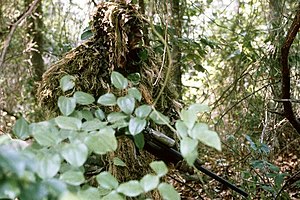
| Part of a series on |
| War (outline) |
|---|
 |
Military camouflage is the use of camouflage by an armed force to protect personnel and equipment from observation by enemy forces. In practice, this means applying colour and materials to military equipment of all kinds, including vehicles, ships, aircraft, gun positions and battledress, either to conceal it from observation (crypsis), or to make it appear as something else (mimicry). The French slang word camouflage came into common English usage during World War I when the concept of visual deception developed into an essential part of modern military tactics. In that war, long-range artillery and observation from the air combined to expand the field of fire, and camouflage was widely used to decrease the danger of being targeted or enable surprise. As such, military camouflage is a form of military deception in addition to cultural functions such as political identification.
Camouflage was first practiced in simple form in the mid 18th century by rifle units. Their tasks required them to be inconspicuous, and they were issued green and later other drab colour uniforms. With the advent of longer range and more accurate weapons, especially the repeating rifle, camouflage was adopted for the uniforms of all armies, spreading to most forms of military equipment including ships and aircraft.
Camouflage for equipment and positions was extensively developed for military use by the French in 1915, soon followed by other World War I armies. In both world wars, artists were recruited as camouflage officers. Ship camouflage developed via conspicuous dazzle camouflage schemes during WWI, but since the development of radar, ship camouflage has received less attention. Aircraft, especially in World War II, were often countershaded: painted with different schemes above and below, to camouflage them against the ground and sky respectively. Some forms of camouflage have elements of scale invariance, designed to disrupt outlines at different distances, typically digital camouflage patterns made of pixels.
The proliferation of more advanced sensors beginning in the 21st century led to the development of modern multi-spectral camouflage, which addresses visibility not only to visible light but also near infrared, short-wave infrared, radar, ultraviolet, and thermal imaging.[1][2][3] SAAB began offering a multi-spectral personal camouflage system known as the Special Operations Tactical Suit (SOTACS) as early as 2005.[4]
Military camouflage patterns have been popular in fashion and art from as early as 1915. Camouflage patterns have appeared in the work of artists such as Andy Warhol and Ian Hamilton Finlay, sometimes with an anti-war message. In fashion, many major designers have exploited camouflage's style and symbolism, and military clothing or imitations of it have been used both as street wear and as a symbol of political protest.
- ^ O’Mahony, Marie (6 May 2019). "Almost invisible". Textile Technology Source. Advanced Textiles Association. Archived from the original on 30 December 2022.
- ^ "ULCANS". Fibrotex Technologies Ltd. Archived from the original on 29 November 2023.
- ^ "Barracuda ULCAS". SAAB. Archived from the original on 8 December 2023.
- ^ "Special Operations Tactical Suit (SOTCAS)". Defense-Update. 27 January 2005. Archived from the original on 24 September 2023.